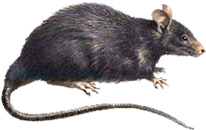|
|
|
|
|
Rodent Identification
 |
Roof Rat: Also known as the Black Rat, Ship Rat, & here in Florida, the Fruit or
Citrus Rat. This is the only rat we have to worry about here in Orlando. All of the rat photos you see on this website are from
Roof Rats. I have never encountered a single Norway Rat down here. Roof rats are usually gray to slightly brown in color. Adults
are typically 8 inches long, with a 9 inch long tail. The tail is long, dark, and scaley. Roof rats prefer warmer, more tropical
climates than |
Norways. Roof Rats get their name because they spend about 90% of their time above ground. The live in trees, run
on power lines, the tops of fences, and they really love to live in the attics of houses. Females have 4-6 litters per year,
with 6-8 young per litter. They are fully weaned within a month, and sexually mature in as little as two months. They don't live
very long in the wild, seldom more than a year. Roof Rats are nocturnal, which is why you hear them scampering in your attic
in the middle of the night.
 |
Norway Rat: Also known as the Brown Rat, this is the giant rat you hear about
living in New York City sewers. It can grow to twice the size of the Roof Rat. The Norway Rat is different from the Roof Rat in
several ways. Norway Rats have a thicker, heavier body, and a shorter tail. They have a more blunt snout. They are usually more
brown in color than the Roof Rats. They prefer to live at ground level, hence their presence in the sewers. They seem to be highly
dependent upon people for food and shelter sources. Like all rats, they have poor vision, and |
rely primarily upon their sense
of smell and their highly specialized senses of feel and balance to survive. As with all rodents, their teeth grow continuously, and thus they gnaw on
many surfaces to wear down their teeth.
 |
House Mouse: The House Mouse is commonly known, but rarely seen here in Orlando.
Many people call me claiming to have seen mice, when they have in fact seen juvenile Roof Rats. You must remember that mice are
very small, less than an ounce in weight. They exhibit behaviors similar to rats. They are nocturnal, like to live in homes,
and destroy food and property with their chewing. |
For pest rat control in other cities, check out
Animal Control Denver in Colorado and
Philadelphia Animal Control in Pennsylvania.
Biology of Norway Rat
Appearance
With a body size of just 9 inches and a tail length of roughly 6 inches, Norway rats (Rattus norvegicus) are medium sized rodents. An average Norway rat weighs in at about one lb. They are also called street rats, hannover rats, brown rats, wharf rats, sewer rats, common rats etc.
The Norway rat has fur covering its entire body, with the exception of its tail and ears. And like most other rat species, Norway rats come in different
colors. They commonly occur in tan, brown, grey and few other colors.
Although naturally plagued with poor eyesight, they are well compensated with their sensitive hearing and highly specialized olfactory system.
Habitat
Norway rats are found everywhere in the world from Asia to North America, South America, Australia, Africa and Europe. Some species are specific to a particular part of the world. The only place Norway rats do not live in is the Antarctica due to the extremism of the weather there.
These furry rodents occur naturally in bushy areas, but are also adapted to living around humans. They can reside in commercial building, churches, residential buildings, farms, schools and so on as long as there is something to feed on.
Diets
Like most other species of rats, Norway rats are omnivores, feeding on both plants and animals. Their most
favored diets include seeds, fruits (such as oranges), tomatoes, leaves, and small vertebrate and invertebrate organisms.
Life cycle
A female rat breeds about 5 times every year, giving birth to between 6 and 12 pups (baby rats) per litter. The gestation period lasts for about 20 to 31 days and the pups are born blind and without hair. Their hairs however grow rapidly as they become stronger and reach maturity by their 2nd month of birth.
Norway rats can live for as long as 1 to 2 years. Environmental conditions, availability of food and predation are the key factors that affect their lifespan. They are often predated by carnivorous animals and birds of prey.
Behavior
They are poor climbers, but make up for that by being very good at swimming and burrowing. Norway rats are social animals, so they usually stay, sleep and eat together in small groups. They are also nocturnal and their main foraging activities take place at night.
Their relationship with man is two-faced. While they are kept as pets and for use as laboratory animals, they are also capable of destroying properties with their non-stop chewing habit.
|
 |
© 2017 OrlandoRats - site content, photos, & maintenance by Orlando Rat Removal, original site by Moonrise Group, Inc |
 |
|
|